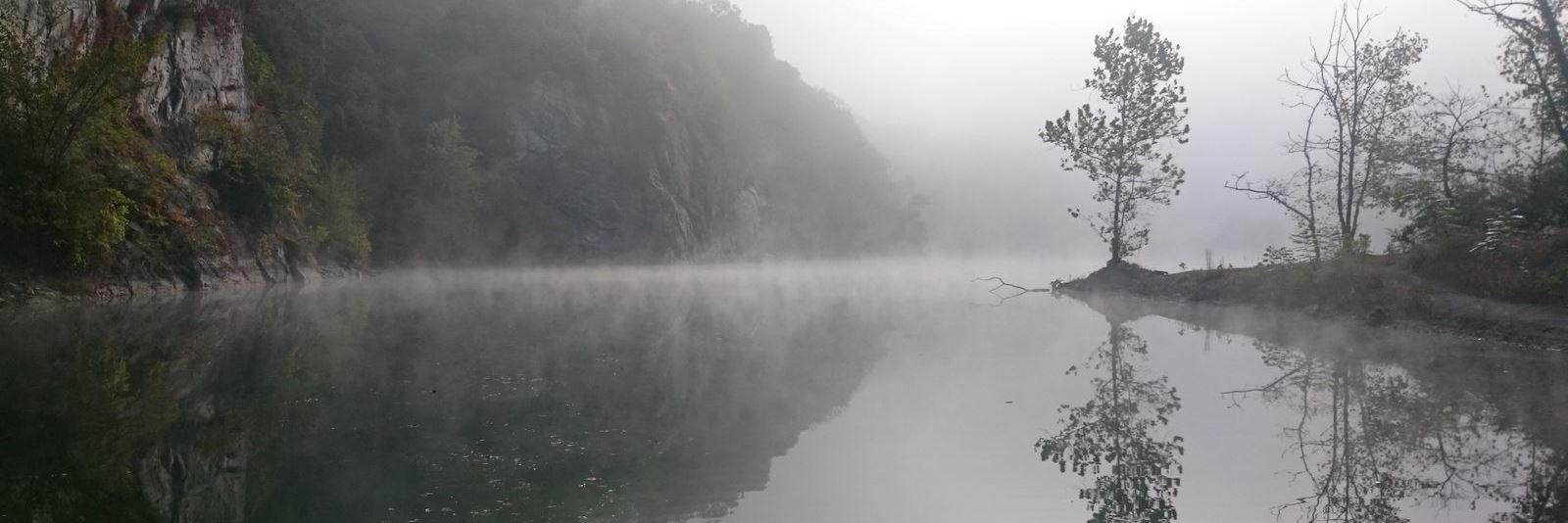Billmeyer Quarry Consumptive Use Mitigation Project
The Commission requires projects to mitigate for their consumptive use (CU) of water. This is intended to address reductions in water availability during low flow periods to avoid water use conflicts and environmental impacts. The Commission strives to encourage and undertake consumptive use mitigation projects through administration of its regulatory program and its own activities funded by consumptive use mitigation fee payments. The Commission uses these monies to acquire water storage that can be used during periods of drought.
The Commission and the Lancaster County Solid Waste Management Authority (LCSWMA) partnered to investigate the 29-acre Billmeyer Quarry in the lower Susquehanna River Basin near Bainbridge, Pennsylvania as a potential CU mitigation asset.
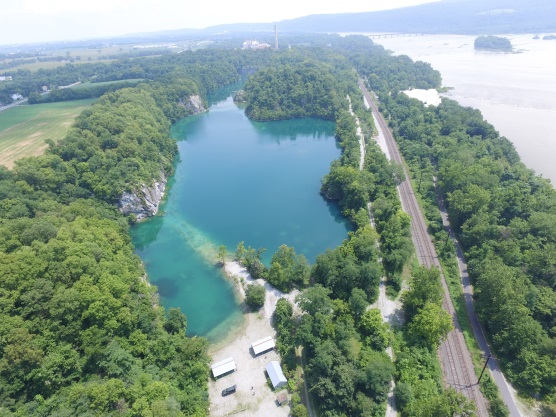 Aerial view of quarry, 2017
Aerial view of quarry, 2017
Quarry History
John Haldeman opened up the quarry in the mid-1800s to produce agricultural lime for farms in the surrounding counties. The quarry and associated kilns expanded over time until World War I, when the demand for high quality dolomite was needed to replace Austrian magnesite. As the demand for the dolomite grew, the quarry expanded in breadth and depth. Houses, roads, and other structures were moved to access the dolomite deposits. Byproducts of the kilning process were deposited on the banks of the Susquehanna River and form what is now called the White Cliffs of Conoy. Economically viable dolomite was exhausted in the 1950s and the plant was closed in 1957. The quarry sat idle until 1981 when it was purchased for use as a scuba diving instructional facility. The quarry was acquired by LCSWMA in 2015. More historical photos of the area can be foundhere.
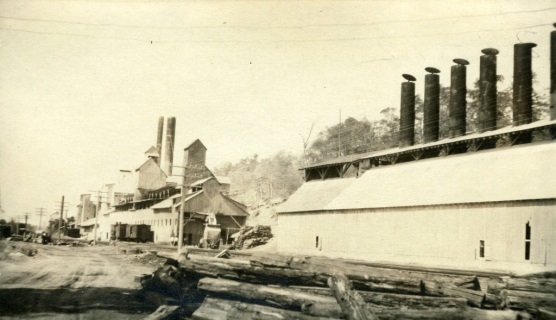
Billmeyer lime plant, undated (PA Geological Survey photo)
Phase I: Preliminary Investigation (2016-2017)
Bathymetric Survey
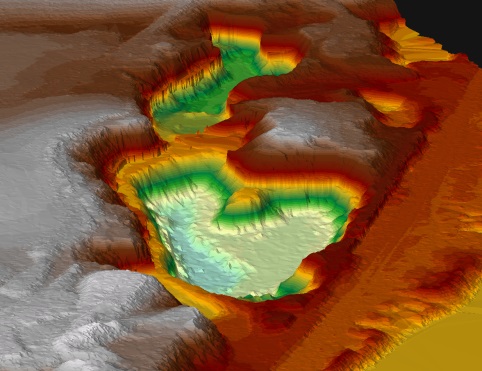 Bathymetric model of quarry
Bathymetric model of quarry
In an effort to quantify the volume of stored water at the site, a bathymetric survey was completed at the site. Over 70,000 data points were collected and processed to create a 3-dimensional map of the quarry. The results indicate that the quarry has a maximum depth of approximately 130 feet below the water surface and a total volume of 484 million gallons. Based on the volume analysis, the Billmeyer Quarry was deemed of sufficient size for CU mitigation.
Endangered Species Survey
Three species were identified and required further investigation: the Virginia Mallow (sida hermaphrodita), the Bald Eagle (haliaeetus leucocephalus), and the Bog turtle (glyptemys muhlenbergii). PA DCNR indicated that the Virginia Mallow would not be impacted by the project. A Bald Eagle screening was conducted and resulted in a determination that disturbances to Bald Eagles were unlikely to occur. The U.S. Fish and Wildlife Service (USFWS) requested a Phase I Bog turtle study due to the local habitat in the area. This was completed by a consultant who concluded that on-site wetlands did not possess the required hydrology, soils, or vegetation suitable for Bog turtle habitat. The USFWS concurred and concluded that the project would have no effect on Bog turtles.
Invasive Species Survey
During the Phase I study, an invasive species, the Quagga mussel, was found in the quarry. These mussels can cause fouling of intake pipes and outcompete native species for resources. Before a quarry pumping test could be undertaken, mitigation of these mussels was required. To learn more about quagga mussels, click here for more information from USGS.
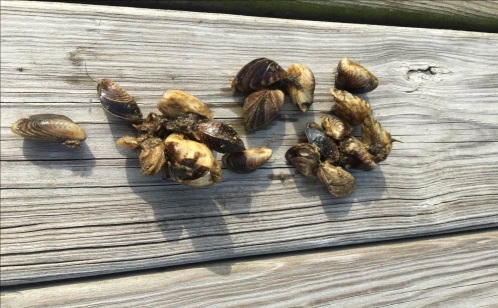
Quagga mussels found in quarry
Phase II: Invasive Species Mitigation & Quarry Pumping Test (2017-2018)
Invasive Species Mitigation
In an effort to eradicate the Quagga mussels from the quarry, the Commission issued an Request For Proposal to remove them from the quarry to prevent any downstream colonization. Earthtec QZ, a proprietary copper-based compound, was used to kill the mussels at the quarry. After several rounds, it was confirmed that all veligers and monitored mussels found within the quarry were eradicated.
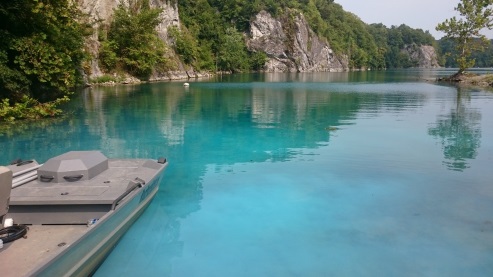
Water at quarry during mussel eradication
Quarry Pump Testing
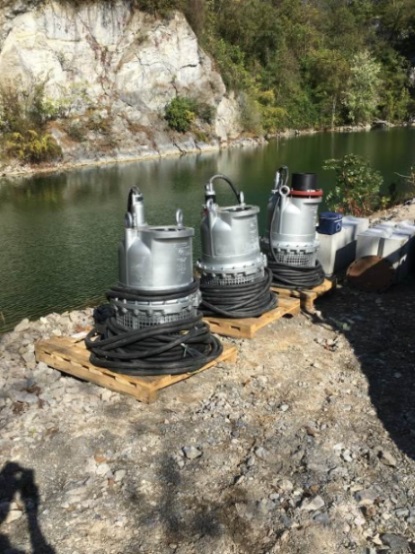 32" Gorman-Rupp pumps with a max capacity of 20,000 GPM
32" Gorman-Rupp pumps with a max capacity of 20,000 GPM
Once all permits, endangered species investigations, and the eradication of the Quagga mussels were completed, the Commission undertook a 35-day pumping test to verify the measured volume, and observe any impacts to the surrounding water resources. The pumping test revealed that the volume of water available for CU mitigation was 425 million gallons while having minimal impact of surrounding water users.
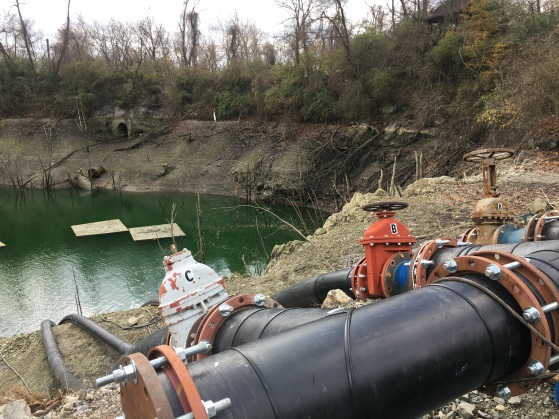 Pumping manifold and valves during testing
Pumping manifold and valves during testing
Phase III: Refilling & Buildout (2018-ongoing)
The Commission observed the refilling of the quarry after dewatering and found that natural recharge would not be sufficient to replenish the water if the asset was needed for consecutive years. This phase will consist of constructing a water withdrawal from the Susquehanna River during periods of high flows, so it can be stored in the quarry during periods of low flows. The Commission will seek all required permits for the water withdrawal as well as any permits need to install any permanent dewatering devices.
Once completed, the quarry will be able to provide 425 million gallons of water to the Susquehanna River during periods of droughts or low flows.
